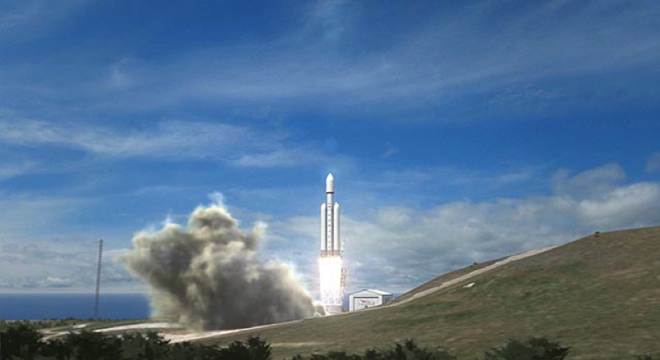SpaceX isn’t wasting any time in the wake of completing the first-ever docking of a commercial spacecraft with the International Space Station on Friday.
The Hawthorne, California based company on Tuesday announced it had signed a deal with Intelsat, a Luxembourg-based international company that describes itself as the “leading provider of satellite services worldwide,” managing over 50 satellites in orbit around the Earth for 1,500 customers.
The precise terms of the contract — such as the cost and duration — weren’t disclosed, but under the deal, SpaceX will use its forthcoming Falcon Heavy rocket to launch one Intelsat satellite into orbit between 2017 and 2019, according to Intelsat spokesman Alex Horwitz.
“Access to space is very important and we support new entrants like SpaceX to the commercial space industry,” Horwitz told TPM in a telephone interview.
Horwitz declined to specify exactly which satellite the company would be sending up on SpaceX’s Falcon Heavy rocket, which is currently under development.
Previously, Intelsat has relied on other commercial satellite launching companies, including International Launch Services (ILS) and Sea Launch, which is scheduled to launch another Intelsat satellite on Thursday from a floating platform located at the equator.
SpaceX’s Falcon Heavy rocket was first announced by CEO and lead designer Elon Musk in April 2011. The craft, which is based on the design of the company’s successful Falcon 9 rocket, would be the largest and most powerful from SpaceX, capable of lifting 117,000 pounds (53 metric tons) into low-earth orbit.
By contrast, the recently-retired fleet of NASA Space Shuttles could lift just under half that amount, some 54,000 pounds (24.4 metric tons) into orbit. The inaugural demonstration flight of the SpaceX Falcon Heavy is planned for sometime in 2013.
SpaceX’s Falcon 9 rocket, which can carry up to 23,000 pounds into orbit, has been successfully launched on three attempts so far, the latest carrying SpaceX’s Dragon capsule into orbit, where it docked with the Space Station and delivered over 1,000 pounds of supplies.
The Falcon Heavy essentially takes the basic design of the Falcon 9 and attaches two more booster rockets to its sides to increase thrust.
“SpaceX is very proud to have the confidence of Intelsat, a leader in the satellite communication services industry,” Musk said in a statement released Friday. “The Falcon Heavy has more than twice the power of the next largest rocket in the world. With this new vehicle, SpaceX launch systems now cover the entire spectrum of the launch needs for commercial, civil and national security customers.”
But first, the company must concentrate on more immediate goals: SpaceX is scheduled to disconnect its Dragon spacecraft from the International Space Station on Thursday, piloting it back toward Earth, where it is supposed to re-enter and parachute into the Pacific Ocean, to be retrieved and reused by SpaceX.
SpaceX’s ultimate goal is to make its entire Falcon line of rockets reusable, dramatically cutting the costs of space flight. Currently, its most recently launched Falcon 9 rocket is orbiting the Earth, where it is scheduled to remain for several months before de-orbiting and burning up in the atmosphere.






